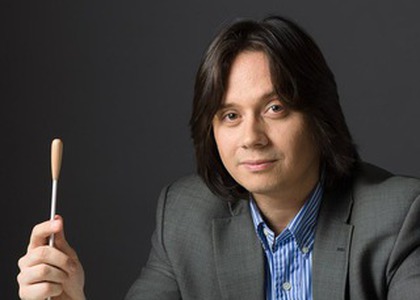> [Archived] Interviews

Interview with conductor Gabriel Bebeselea
Today, on the stage of the Radio Hall, there is a new concert included in the Radio Orchestras and Choirs season. This time, the soloist will be the violinist Alexandru Tomescu. Conductor Gabriel Bebeșelea will be at the lectern, from whom we will learn details about the proposed program.
Mr. Gabriel Bebeșelea, what can you tell us about the program chosen for this concert? I am referring in particular to the "Symphony of Youth" composed by Sergei Rachmaninov, which also has a special history.
Rachmaninov's "Symphony of Youth" was composed by him as his undergraduate work at the end of the Conservatory, at the suggestion of Arensky and Taneyev, his composition teachers, but they were not very pleased with it, although the symphony has a lot of note Rachmaninov's personal work, even if there are many references to Tchaikovsky IV, even Tchaikovsky III; but the very condensed rhythmicity of Rachmaninov is already noticeable. I chose the piece in the opening of Glazunov's Violin Concerto, because there is a connection between the two, even if not a very happy one. Glazunov was the one who conducted the premiere of Symphony no. 1 by Rachmaninov, not a happy experience because the symphony was a complete failure: Glazunov had apparently consumed a lot of spirits before the concert and before each rehearsal and because of this the orchestra did not know what to do, the symphony being a unprecedented complexity for that era. So, after the failure of the First Symphony, Rachmaninov went into a terrible depression, he did not compose for a long time and this depression followed him until the end of his life, and even in Symphonic Dances he quotes himself from this First Symphony which is perfectly connected by " The Symphony of Youth" that he had composed a few months before. It is a program that has a history behind it, in the first part of the concert.
This is not the first time you direct this work. How has your vision of this score changed over this time?
It has changed, but not much, because I always associate it with the other works of Rachmaninov that followed. Everything that happens in Rachmaninov's work is very autobiographical and it is important to know the obsessions that he had. We do not yet meet in this Youth Symphony for example, the Dies Irae, but there are very many preparations to say for the Isle of the Dead in the introduction or for the Symphonic Dances or for other works that will follow. The way they build it is like a preparation for what is to come in Rachmaninov's creation; and as for the Glazunov Concerto, the orchestration is extremely similar and extremely colorful, and I'm very happy to have AlexandruTomescu as a soloist because it brings out a lot of layers and a lot of subtleties that Glazunov wrote in this violin concerto.
The Symphony of Youth by Sergei Rachmaninoff and the Violin Concerto by Glazunov, as well as the "Enigma" Variations by Elgar, are works less addressed by Romanian orchestras. Therefore, what aspects become important while working with the orchestra?
As I said, in this program the biographical perspective of the composer is very important, I believe, because for instance in the case of the "Enigma" Variations everything happens around Elgar's intimate circle, each variation is dedicated to a known or to a good friend of his and there are events that changed the course of his life, which we find in these Enigma variations. For example, the two most important variations are: the first, which is dedicated to his wife, and no. 9, which is dedicated to his publisher at Novello Publishing in London, who actually persuaded him not to give up composing during an equally depressed period when Elgar wanted to give up composing altogether and devote himself solely to teaching. That is why the Nimrod variation is perhaps the quintessence of this work, and the two variations are the only ones that are quoted at the end of the work when Elgar describes himself and actually proves that his wife and his publisher were the most important people in his life - proof that they built and constituted including the last variation.
Translated by Cosmin Ionuț Petriea,
University of Bucharest, Faculty of Foreign Languages and Literatures, MTTLC, year I
Corrected by Silvia Petrescu














